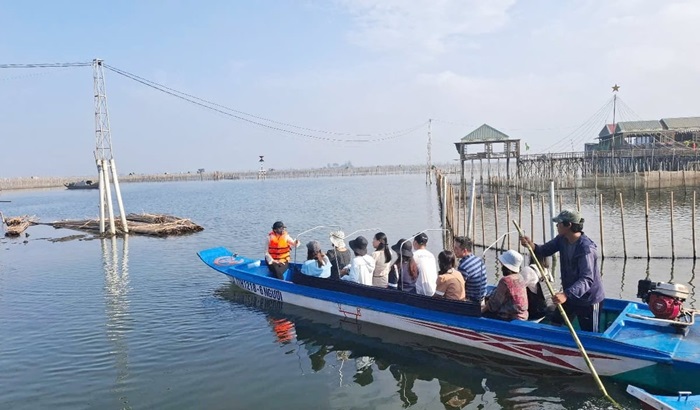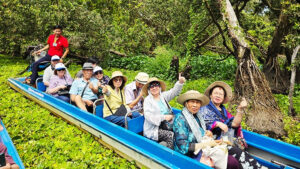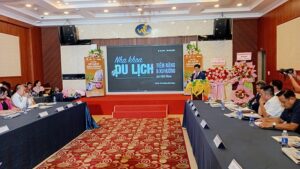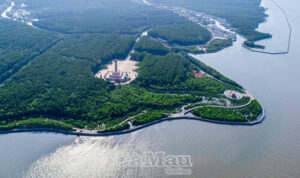Lam Kinh, which means Blue Capital, was named after the surrounding Lam Son (Blue Mountains). During the 15th century, Lam Son was a base for the insurrection against the Chinese Ming conquerors, led by the national hero Le Loi, who later became the first king of the Le Dynasty.
Lam Kinh lies 50 km west of Thanh Hoa city, in Tho Xuan district, Thanh Hoa province. The former capital borders the Dau Mountains in the north, the Chu River and the Muc Mountains in the south.
High mountains and lush green forests tower on both sides, creating a panoramic landscape. The capital includes the Royal Temple, built to worship the royal ancestors, and a mausoleum, in which the monarchs of the Le Dynasty once rested in peace.
Construction on Lam King began in 1433, right after the death of King Le Thai To, the first of the Le Dynasty. Building a second capital, with monuments and mausoleums in Lam Son strengthened the loyalty of the people to the King and the reigning family.
Along with mausoleums, the Le Dynasty also built three rostrums in Lam Kinh. The Wind and Cloud temple was used to pray for favorable weather for the harvests. The second was for Society, where wishes for a wealthy life were made. The third, South Communion, was where Kings made “reports” and expressed their gratitude to the heavens.
Through periods of change, the remaining relics of Lam Kinh include the diverse and varied cultural content that illustrates the history of Vietnam.
Wars and time have destroyed most of the magnificent architectures of Lam Kinh. The only things that can reminds us of a splendid capital of the past are the moss grown terraces and stone pillars, beaten white by rain and sun.
After half a millennium, among eight royal mausoleums that were built in Lam King, only three still remain. They are the first King Le Thai To, the third Le Thanh Tong and the fifth Le Hien Tong of the Le Dynasty.
Relics have revealed that were once large structures with delicate stone sculptures in this area. However, most of the stele-houses of eight mausoleums have been destroyed.
Only the stone turtles that once carried the steles still sit calmly in the ruins of Lam Kinh. Among them is the biggest stele of Vietnam, named Vinh Lang, which was made in 1433 after Le Thai To’s death to commemorate his life.
Today, as in its glorious past, Lam Kinh is a beautiful, quiet place to visit and reflect on life. Many religious and symbolic ceremonies are still held at Lam Kinh each year in Tho Xuan district, a place with much historic significance.
On the eighth month of the lunar calendar, the festival of Lam Kinh is held to commemorate King Le Thai To’s death. It is characterized by traditional performances of the central Vietnam, including the colorful light and dragon dances.
In recognition of its historic, cultural, artistic and architectural value, in 1994 the Government made a project to reconstruct and repair Lam Kinh.
The Comprehensive Restoration Project was implemented in 10 years from 1994 to 2004. It includes the conservation of mausoleums, Le Loi Temple and the 34-ha Lam Son forest.
Archaeologists have excavated large areas of over 3,000 square meters, but no exact description of the locations and name of palaces and temples has been ever made.
Experts still wonder if Lam Kinh was purely a ritual place or a real second center of the nation’s political, cultural and military activities.
Relics of the past serve as evidence of magnificent and distinctive architectural works which used to be prevalent in the area, including the remains of sophisticated stone-carved works found in old temples, palaces and citadels, especially in the Le royal tombs. Two big tombs which remain until the present times include that of Queen Ngo Thi Ngoc Dao and particularly, Vinh Lang tombstone which is to commemorate Le Loi, founder of the Le Dynasty, as the biggest stele of Vietnam with 2.97 meters in height, 1.94 meters in width and 0.27 meter in thickness.5km from Lam Kinh is a temple where local people worship Le Lai, a courageous general and national hero who had chosen to die in order to save King Le Loi’s life. All these places are attractive historical sites for tourists.














